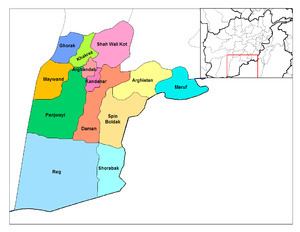6,000 Thousands Start date June 1987 Location Arghandab District | 500 killed and wounded, 1200 captured or deserted At least 60 killed Result Mujahideen victory | |
 | ||
Similar Soviet–Afghan War, Siege of Urgun, Battles of Zhawar, Siege of Khost, Operation Magistral | ||
The Battle of Arghandab was an offensive launched by Afghan government forces, supported by Soviet troops against Mujahideen strongholds in the Arghandab District of Kandahar Province, Afghanistan. The operation ended in failure, and the government forces withdrew after suffering heavy losses.
Contents
Prelude
During the Soviet war in Afghanistan, the Afghan mujahideen had important forces in the Kandahar area. These were affiliated with different parties, and while they cooperated with each other, they were unable to form a unified command. The principal commanders were Mullah Naqib of Jamiat-e Islami, Lala Malang of Hezb-e Islami Khalis and Abdul Latif of the National Islamic Front of Afghanistan. In early 1987, the mujahideen launched an attack in and around Kandahar. Diversionary raids targeted Soviet and WAD positions, but the main objective were the defensive outposts manned by pro-government militias defending the city. These were the Jowzjani Uzbek militia of Abdul Rashid Dostum, the Achakzai militia of Ismatullah Muslim, and a Baluch force under Meri Baluchis. The militias suffered heavily in the attack, causing the government to plan a retaliatory offensive against resistance strongholds in the Arghandab District.
Battle
The Soviet-Afghan force that was organised for the circumstance was composed of 6,000 men drawn from the 15th Division and the 7th Tank Brigade, stationed near Kandahar, with reinforcements from the 14th and 17th Divisions, and from local militias and troops brought in from Kabul. The Soviets contributed the 70th Motorized Rifle Brigade and air units, but the bulk of the force was composed of Afghan forces, and the Soviet role was limited to support missions. The communist regime sent its defense minister and interior minister to oversee the operation.
The terrain of Arghandab district presented several difficulties for an attacking force. Situated in a lush agricultural area along the Arghandab River, it is crossed by many deep irrigation ditches which limit and channelize the movement of armoured vehicles, as well as providing cover for the defenders.
The offensive began on May 22, supported by massive artillery and aviation strikes. After some aircraft were shot by Mujahideen Stinger missiles, the Soviet helicopter gunships which had provided much of the air support were called off. The Afghan troops found themselves facing entrenched Mujahideen, dug in to camouflaged bunkers, and their morale suffered accordingly. The government troops often refused to attack, and large numbers defected to the resistance with their weapons. By the end of June the offensive ended. The DRA losses were 500 killed and wounded, as well as 1200 defections. The Mujahideen lost 60 killed defending Chaharqulba, the stronghold of Mullah Naqib, and "many others" in other areas.
